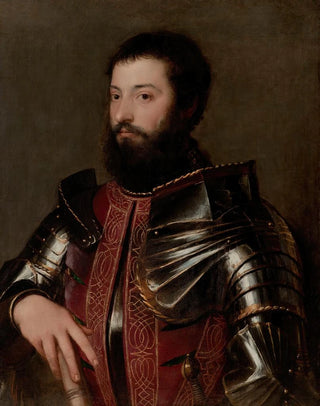Art print | Portrait of a man in armor - Titian


View from behind

Frame (optional)
Reproduction Portrait of a Man in Armor - Titian – Captivating Introduction
The "Portrait of a Man in Armor," an iconic work by the Venetian master Titian, embodies the pinnacle of Renaissance portrait painting. This painting, which captivates with its intensity and realism, immerses us in a world where identity and power intertwine with unmatched delicacy. The man, whose face is both impassive and emotionally charged, draws attention with his majestic presence, while the armor, a symbol of bravery and nobility, sparkles under the light, revealing the artist's exceptional craftsmanship. This art print, faithful to the original, allows for appreciation of every detail of this masterful work, while offering a window into the era in which it was created.
Style and uniqueness of the work
Titian's style is distinguished by his mastery of colors and textures, which breathe life and depth into his portraits. In "Portrait of a Man in Armor," the contrast between shadow and light highlights the structure of the face and clothing, creating an atmosphere that is both realistic and almost mystical. The shades of black and silver in the armor harmonize with the warm tones of the skin, while the dark background emphasizes the presence of the subject. This work also stands out for its psychological approach; the gaze of the man, both serene and penetrating, seems to tell a story, an introspection on power and human fragility. The carefully balanced composition and the choice of details, such as the ornaments of the armor, testify to Titian's skill in capturing not only appearance but also the soul of his models.
The artist and his influence
Titian, whose real name is Tiziano Vecellio, is one of the greatest masters of Italian painting. Active during the 16th century, he established himself as the leader of the Venetian school, influencing many artists across Europe. His ability to innovate while remaining faithful to Renaissance traditions marked his era. By integrating elements of mythology, religion, and portraiture into his work, Titian redefined standards

Matte finish

View from behind

Frame (optional)
Reproduction Portrait of a Man in Armor - Titian – Captivating Introduction
The "Portrait of a Man in Armor," an iconic work by the Venetian master Titian, embodies the pinnacle of Renaissance portrait painting. This painting, which captivates with its intensity and realism, immerses us in a world where identity and power intertwine with unmatched delicacy. The man, whose face is both impassive and emotionally charged, draws attention with his majestic presence, while the armor, a symbol of bravery and nobility, sparkles under the light, revealing the artist's exceptional craftsmanship. This art print, faithful to the original, allows for appreciation of every detail of this masterful work, while offering a window into the era in which it was created.
Style and uniqueness of the work
Titian's style is distinguished by his mastery of colors and textures, which breathe life and depth into his portraits. In "Portrait of a Man in Armor," the contrast between shadow and light highlights the structure of the face and clothing, creating an atmosphere that is both realistic and almost mystical. The shades of black and silver in the armor harmonize with the warm tones of the skin, while the dark background emphasizes the presence of the subject. This work also stands out for its psychological approach; the gaze of the man, both serene and penetrating, seems to tell a story, an introspection on power and human fragility. The carefully balanced composition and the choice of details, such as the ornaments of the armor, testify to Titian's skill in capturing not only appearance but also the soul of his models.
The artist and his influence
Titian, whose real name is Tiziano Vecellio, is one of the greatest masters of Italian painting. Active during the 16th century, he established himself as the leader of the Venetian school, influencing many artists across Europe. His ability to innovate while remaining faithful to Renaissance traditions marked his era. By integrating elements of mythology, religion, and portraiture into his work, Titian redefined standards






